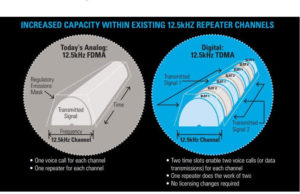Is It Time to Migrate to Digital? Part Two: Better Capacity
Case Study | 0 comments | by Vanessa Chavez
In Part Two of this series on Digital Migration, we discuss Better Capacity.

Part Two: Better Capacity
Regulatory pressures and real-world needs are driving a demand to expand the capacity of the business designated slice of the RF spectrum by leveraging new technology. As it happens, digital two way radio technology is very bandwidth efficient and actually allows two separate “channels” to operate on a single 12.5 kHz frequency. Effectively doubling its capacity. (See chart Above)
In addition to making efficient use of the RF spectrum, this feature helps minimize licensing costs associated with operational expansion because the additional channels do not require additional frequencies. For a fast growing business that is expanding its radio operations this can mean significant savings while expanding communications.
read more
Mall of America (MOA) is one of the most visited tourist destinations in the world. Minutes from Minneapolis and St. Paul, it is the biggest mall in the U.S. with 520 stores, 50-plus restaurants and
attractions galore, including the nation’s largest indoor theme park.
Over 40 million visitors pass through its doors each year – almost eight times the population of the entire state of Minnesota. At 96 acres, the size of seven Yankee baseball stadiums, and over 12,000 employees, the scale of MOA presents significant communication challenges. Like many operations with older analog radio systems, MOA was experiencing persistent coverage and frequency issues. Employees were interrupted by interference and loud static blasts over their analog radios. This was particularly annoying for team members who wore earpieces. Certain areas of the massive mall were punctuated by dead zones, forcing employees to walk to another location to communicate on their radios or use personal cell phones.
read more
